Professor on quest for India's hidden inventors
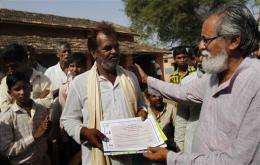
(AP) — It's 43 degrees Celsius (110 F), and Prof. Anil Gupta has been hiking the scorched plains of central India for hours. But he smiles widely as he enters a tiny village in search of another unsung genius.
"If you have any new ideas or you have any new inventions, I'm here to promote you," he tells farmers squatting beside a dusty roadside shrine to the Hindu god Shiva.
For more than two decades, Gupta has scoured rural India for its hidden innovations, motivated by the belief that the most powerful ideas for fighting poverty and hardship won't come from corporate research labs, but from ordinary people struggling to survive.
Gupta and his aides have uncovered more than 25,000 inventions, from the bicycle-mounted crop sprayer to the electric paintbrush that never needs to be dipped in a paint can.
Many of the cheap, simple ideas he spreads for free from one poor village to another with the inventor's blessing. Some he is working to bring to market, ensuring the innovator gets the credit and the profit that will spur others to create as well. Many ideas are simply documented in his database waiting for some investor to spot their potential. He routinely dispenses tiny grants, either from a government fund or his own web of organizations, to help poor innovators finish their projects.
The 59-year-old management professor with a thick graying beard reminiscent of an ascetic holy man says he gets no financial benefit from his finds, reveling instead, with almost childlike joy, in the process of discovery itself.
"Every time we walk in a place we discover a solution that we would not have imagined, and we find that eagerness," he said.
Many finds focus on agriculture: a more productive strain of peppers, a makeshift seat that lets coconut harvesters rest high up in trees, a hollow spear that pierces a hole in a field and drops in a seed.
There are traditional herbal medicines for cracked heels and sore muscles, stoves and engines modified to be more efficient, and a rice cleaner designed by a 13-year-old after he watched his mother wearily picking pebbles from yet another sack of grain.
And there are the eyebrow-raisers: the washing machine mounted on the back of a scooter and powered by its engine, the bulletproof vest packed with herbs that absorb the concussive force of the bullet, the amphibious bicycle.
Gupta has received the Padma Shri, one of the Indian government's top honors. He works with India's president to fete the innovators. He helped found the government-sponsored National Innovation Foundation, routinely addresses top business conferences and recently linked up with one of India's largest retailers, Future Group, to bring some of the most promising finds to market.
Consumers will be attracted to the products — everything from all-natural cookies to a toothbrush that adds its own toothpaste — because the profits go to a good cause and because of the subtle simplicity of the inventions, said Ashni Biyani, a top Future Group executive.
"These are ideas that are rooted within the context of India," she said.
Gupta's explorations have boosted inventors throughout rural India who, much like the "mad" uncles tinkering away in garages around the world, are dismissed as nuts by their neighbors until he arrives and declares them geniuses.
Take Nattubhai Vader, a farmer from the state of Gujarat, who watched women and children harvesting an especially troublesome variety of cotton and figured there had to be a better way.
Vader designed and then obsessively tweaked a massive apparatus of spinning rubber hoses and vacuums that fits over a tractor and can pick as much cotton in one hour as 10 people can in two days, he said.
He sank more than $20,000 into the harvester before his wife threatened to divorce him if he didn't save the family's remaining money for their kids' education. A few years later, Gupta found Vader, gave him the funding to restart and now plans to bring in a team of engineering students to refine it.
At the heart of Gupta's mission are his grueling weeklong Shodh Yatras, consisting of 20 kilometer (12 mile) daily hikes in the searing summer and frigid winter, nights spent sleeping in school courtyards, meals of watery lentils. The idea is to scare off uncommitted "tourists" and give participants a taste of peasant life.
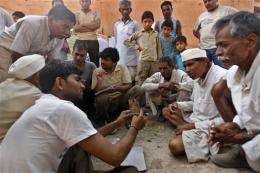
"Your eyes will open and you will see things you've never seen before," Akash Badave, a 23-year-old preparing to be rural administrator, says Gupta told him before the first of his three Shodh Yatras. "And that was the case."
On one recent trek along parched hillsides in the central state of Madhya Pradesh, Gupta was accompanied by dozens of followers: young urbanites curious about rural poverty, an engineer who came to find herself, a team of inventors he collected from his previous journeys.
He began the hike after arriving on an overnight flight from China, marched in rubber sandals, drank little water despite the heat and even fasted for a day.
His arrival at a village rarely visited by outsiders was an event akin to the circus coming to town.
He handed out colorful magazines and pamphlets showing farmers how to make natural pesticides out of local plants, to treat cattle diseases with spice mixtures, to prolong the life of their water pump by sticking an old tire under the handle. And he appealed to them to come up with ideas of their own.
"Solutions to our problems are not so scarce," he declared.
As an example, he introduced Amrit Agrawat who more than two decades ago was watching women in his village struggle to pull heavy water buckets from a well. Agrawat made a pulley with an automatic brake so the women could rest without the bucket plunging back down. It costs $7.
Wonderful, one man said, "now my wife can answer her cellphone while she gets water."
Agrawat has sold 5,000 of his pulleys, but donated one to each village along the way and encouraged the farmers to copy it for themselves.
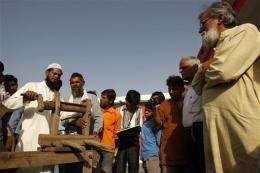
In Dhaboti, Gupta was escorted through the streets by a drummer calling out the villagers, Murali Dar, 80, hobbled over on a cane, holding twigs from a tree. A powder made from these can cure a fever, he said. Another man brought herbs to cure jaundice, yet another a wild lemon for animal cramps.
Kanhiaya Lal, 62, brought branches he uses to make an antidote for snake bites.
"If I die, the secret will die with me of how to cure people," he said.
The offerings were documented by assistants with notebooks. Then, in a simple ceremony that reduced its participants to silent awe, Gupta gave each man a certificate and draped a shawl on his shoulders.
In the village of Moghra, a truck halted in a cloud of dust in the courtyard where Gupta and his team had spent the night. Abdul Rahim Khan had rushed over when his brother told him of the arrival of a man who might finally appreciate his work.
The farmer unloaded a miniature cotton gin that cost less than $4 to make and saved 10 times as much each year in processing fees. "A very good idea," Gupta pronounced. Next was a wooden fodder cutter he made for a fraction the cost of the metal ones on the market.
Any more ideas? Gupta asked.
Khan had been toying with a design for a more efficient soybean harvester, but he didn't have the 8,000 rupees ($150) for a prototype, he said.
Gupta promised him the money.
Khan's obsessions had made him an object of ridicule. Now, "I'm feeling very happy that someone has recognized my ideas and is trying to take it forward," he said.
Gupta was pleased as well. Out-of-the-box thinkers need to be encouraged, not insulted, he said.
Gupta insisted every one of his 29 treks had yielded innovations. If the men didn't bring him inventions, he called on the women to bring recipes — "chemistry," he said. He interviewed every centenarian he met, documenting their secrets of longevity and dismissing doubts they may not be anywhere near as old as they claimed.
He carried a spoon and small plastic bags to dig up dirt — "microbial memories" — for later analysis, and photographed anything that caught his eye, such as an interesting paint job.
Gupta ran excitedly to a field being plowed and stepped through a barbed wire fence. He had heard tractor owners in the area were filling their tires with water to make them heavier for digging into the hard soil.
He located Ghanshayam Yadav, the man credited with having the idea in 2004. Farmers were having trouble plowing the increasingly dense fields and the tractor company was charging 10,000 rupees ($180) for 80 kilogram (175-pound) weights, Yadav said. Instead, he pumped 200 kilograms (440 pounds) of water into the tires for just 200 rupees ($4).
Cheaper, better, longer lasting, more efficient. "This is an amazing experiment," Gupta said. He gave Yadav a shawl.
Gupta's most successful finds include more productive varieties of rice, wheat and other crops that have been widely adopted. He has licensed out pest control mixtures, pet medicines and a psoriasis cream and is looking for partners to market crop growth promoters, a treatment for animal diarrhea and a natural mosquito repellant.
His team helped A. Muruganantham sell hundreds of his machines for making cheap sanitary napkins from wood fiber. And he takes pride in his most successful discovery, Mansukhbhai Prajapati, a once struggling potter who parlayed a clay refrigerator that cools by evaporation into a kitchenware company employing 30 people.
Gupta began as a bank loan officer before working in the 1980s with farmers in Bangladesh, where he was amazed at the creativity of the poor.
When he came home to India, he dedicated himself to fostering that creativity and ensuring poor innovators got properly compensated. He founded his Honeybee Network in the 1980s to connect people and ideas, lobbied the government to create the National Innovation Foundation and set up a network of related organizations to encourage inventors. He soon began touring rural India searching for inventors and spreading ideas.
"Before he came we never really thought about innovation," farmer Hari Singh, 85, said after Gupta presented ideas for harvesting rainwater and making a natural pesticide with local leaves that animals shy away from. His son Kunwar said he was inspired to develop experiments of his own.
Gupta dreams his ideas will expand beyond India's borders, with treks for knowledge spreading to the unexplored corners of the globe.
For now he presses on, jumping over a ditch in a dried up lake bed on his way to the next village.
"There's so much to see," he says. "You would need several lifetimes."
Notable inventions discovered by Indian professor
Indian professor Anil Gupta has spent decades scouring the Indian countryside searching for unsung inventors in rural villages. He works in the belief that the most powerful ideas for relieving poverty and hardship in the country won't come from corporate research labs but from those struggling to survive. He has documented 25,000 innovations from the bicycle-mounted crop sprayer to the bulletproof vest made of herbs. Here's a look at some other innovations he's found:
COTTON HARVESTER: Nattubhai Vader, a farmer from the state of Gujarat, invented a special cotton harvester that fits over a tractor after watching women and children performing the slow grueling work of harvesting an especially troublesome variety of cotton.
COCONUT PLUCKER: The late farmer M.J. Joseph, also known as Appachan, had only a fourth grade education but was still able to create a device for climbing coconut trees to harvest the fruit.
WATER WALKERS: Dwarka Prasad had heard about a fraudster holy man who claimed he could walk on water. Intrigued, he decided to design special water walking shoes that would allow the wearer to walk or skate across a lake.
PERPETUAL PAINTBRUSH: Jahangir Ahmad devised an electric paintbrush that pumps paint from a hose directly to the brush and never needs to be dipped into a can.
ALOE VERA GEL MAKER: Dharamveer Kamboj made a tabletop machine that can cheaply make aloe vera gel from aloe leaves.
WATER TIRES: Farmers in the state of Madhya Pradesh brushed aside tractor salesmen who were trying to sell them expensive weights to help their tractors work the thick, hard soil there. Instead, they filled the tires with water, making the tractors heavier for a minimal cost.
LEG-POWERED WASHING MACHINE: High school student Remya Jose was forced to do laundry by hand when her mother got sick because her family had no washing machine. So she invented a washing machine/exercise bike that is cheap to make and requires no electricity.
WELL PULLEY: Amrit Agrawat wanted to help the women in his village who were struggling to pull heavy water buckets from a well so he made a pulley with a brake to let the women rest midway through their labor.
-
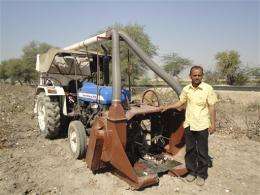
In this undated photo provided by the National Innovation Foundation, Nattubhai Vader stands next to a machine called Cotton Harvester, which he invented in India. Vader, a farmer from the state of Gujarat, invented the apparatus that fits over a tractor after watching women and children performing the slow grueling work of harvesting an especially troublesome variety of cotton. (AP Photo/National Innovation Foundation) -
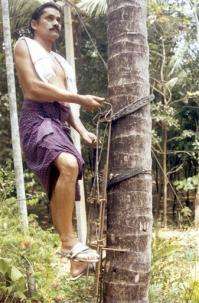
In this undated photo provided by the National Innovation Foundation, late farmer M.J. Joseph, also known as Appachan, from Kerala, India demonstrates his invention called the Tree Climbing Machine. (AP Photo/National Innovation Foundation) -
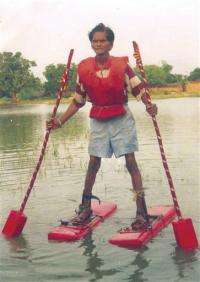
In this undated photo provided by the National Innovation Foundation, Chourasiya demonstrates a pair of wearable floats called Water Walking Shoes he invented in India. Prasad had heard about a fraudster holy man who claimed he could walk on water. Intrigued, he decided to design special water walking shoes that would allow the wearer to walk or skate across a lake. (AP Photo/National Innovation Foundation) -

In this undated photo provided by the National Innovation Foundation, Jahangir Ahmad demonstrates his invention called Electric Painting Brush in India. The device pumps paint from a hose directly to the brush and never needs to be dipped into a can. (AP Photo/National Innovation Foundation) -
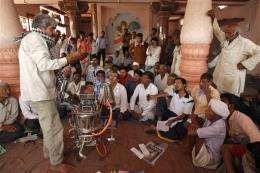
In this Saturday, May 26, 2012 photo, Dharamveer Kamboj, left, an innovator, explains his aloe vera processor invention in a temple in the village of Lasukiya in the Sehore district of Madhya Pradesh, India. The tabletop machine can cheaply make aloe vera gel from aloe leaves. (AP Photo/Rafiq Maqbool) -

In this Thursday May 24, 2012 photo, an Indian villager drives a tractor whose rear tires are filled with water for added weight to work on a field in the village of Dawatha in the Sehore district of Madhya Pradesh, India. Farmers in the state of Madhya Pradesh brushed aside tractor salesmen who were trying to sell them expensive weights to help their tractors work the thick, hard soil there. Instead, they filled the tires with water, making the tractors heavier for a minimal cost. (AP Photo/Rafiq Maqbool) -
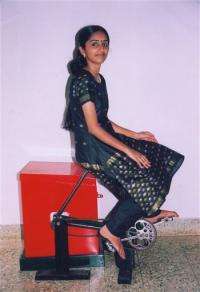
In this undated photo provided by the National Innovation Foundation, Remya Jose from Kerala, India demonstrates the pedal-powered washing machine she invented. Jose was forced to do laundry by hand when her mother became sick because her family had no washing machine. So she invented a washing machine/exercise bike that is cheap to make and requires no electricity. (AP Photo/National Innovation Foundation) -
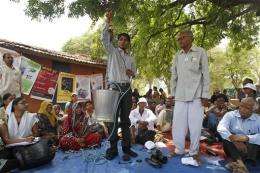
In this Thursday, May 24, 2012 photo, inventor Amrit Agrawat, center right, stands by his assistant demonstrating his pulley with a braking mechanism in the village of Nayapura in the Sehore district of Madhya Pradesh, India. Agrawat wanted to help the women in his village who were struggling to pull heavy water buckets from a well so he made a pulley with a brake to let the women rest midway through their labor. (AP Photo/Rafiq Maqbool)
More information:
Websites relating to Indian innovation:
www.nif.org.in/
www.sristi.org/cms/
www.gian.org/
Gupta's talk for the nonprofit TED organization: www.youtube.com/watch?v=JHk9YVjhk7c
Copyright 2012 The Associated Press. All rights reserved. This material may not be published, broadcast, rewritten or redistributed.
















